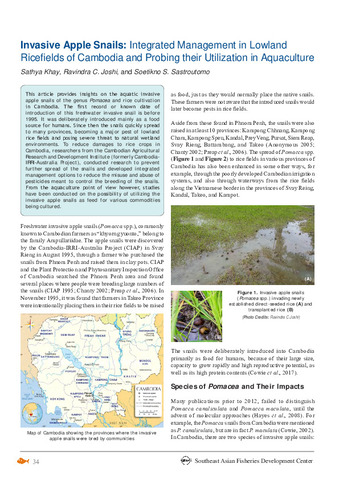បង្ហាញកំណត់ត្រាសាមញ្ញសម្រាប់ធាតុ
Invasive apple snails: Integrated management in lowland ricefields of Cambodia and probing their utilization in aquaculture
Share
| dc.contributor.author | Khay, Sathya | |
| dc.contributor.author | Joshi, Ravindra C. | |
| dc.contributor.author | Sastroutomo, Soetikno S. | |
| dc.date.accessioned | 2019-01-03T03:31:49Z | |
| dc.date.available | 2019-01-03T03:31:49Z | |
| dc.date.issued | 2018 | |
| dc.identifier.citation | Khay, S., Joshi, R. C., & Sastroutomo, S. S. (2018). Invasive apple snails: Integrated management in lowland ricefields of Cambodia and probing their utilization in aquaculture. Fish for the People, 16(3), 34-37. | en |
| dc.identifier.issn | 1685-6546 | |
| dc.identifier.uri | http://hdl.handle.net/20.500.12066/4329 | |
| dc.description.abstract | This article provides insights on the aquatic invasive apple snails of the genus Pomacea and rice cultivation in Cambodia. The first record or known date of introduction of this freshwater invasive snail is before 1995. It was deliberately introduced mainly as a food source for humans. Since then the snails quickly spread to many provinces, becoming a major pest of lowland rice fields and posing severe threat to natural wetland environments. To reduce damages to rice crops in Cambodia, researchers from the Cambodian Agricultural Research and Development Institute (formerly Cambodia-IRRI-Australia Project), conducted research to prevent further spread of the snails and developed integrated management options to reduce the misuse and abuse of pesticides meant to control the breeding of the snails. From the aquaculture point of view however, studies have been conducted on the possibility of utilizing the invasive apple snails as feed for various commodities being cultured. | en |
| dc.language.iso | en | en |
| dc.publisher | Secretariat, Southeast Asian Fisheries Development Center | en |
| dc.subject | Cambodia | en |
| dc.title | Invasive apple snails: Integrated management in lowland ricefields of Cambodia and probing their utilization in aquaculture | en |
| dc.type | magazineArticle | en |
| dc.citation.volume | 16 | |
| dc.citation.issue | 3 | |
| dc.citation.spage | 34 | |
| dc.citation.epage | 37 | |
| dc.citation.journalTitle | Fish for the People | en |
| dc.subject.asfa | utilization | en |
| dc.subject.asfa | pesticides | en |
| dc.subject.asfa | feed composition | en |
| dc.subject.asfa | rice fields | en |
| dc.subject.asfa | inland water environment | en |
| dc.subject.asfa | aquaculture | en |
| dc.subject.asfa | breeding | en |
| dc.subject.asfa | Environments | en |
| dc.subject.asfa | fresh water | en |
| dc.subject.asfa | new records | en |
| dc.subject.asfa | research | en |

